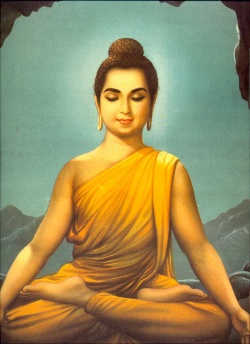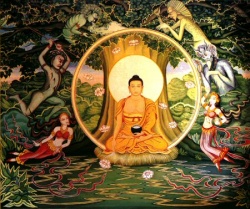How Siddhartha Gautama Became the "Buddha"
Siddhartha Gautama lived in northern India in the 6th century C.E. He was born into a Hindu family of the ruling caste. Ancient Buddhist texts record slightly different stories about his life and how he became a "Buddha" or "enlightened one." Here is the most common version.
Siddhartha was about 5 days old when his father called a group of priests together for a feast. He asked them about the infant's future. They prophesied that the infant would either become a great king or a great sage. The father preferred his son to become a great king, so he structured his son's life such that he never had to face any of the hardship or struggles of life.
Why?
Because in the Hindu tradition of the time (which you can read about here), those who became holy men or sages followed a path of renunciation. At a certain point in their lives, they would renounce what was called "householder" life - a life of marriage, family, work, etc. - and go live in the forest where they spent the rest of their lives in study, meditation and other spiritual practices.
Siddhartha's father did not want his son to become one of these renouncers, so he made sure his son's life was as perfect as possible, offering everything wonderful and nothing negative or upsetting. The father made sure his son was shielded from anything that would make him want to leave the kingdom.
One day, as Siddhartha was touring a park area of the kingdom, he saw four things that changed his life. First, he saw a sick person. He had never seen a sick person before and was shocked at the sight. Next, he saw an old person, someone stooped over and suffering the effects of old age. Again, he was shocked for he'd never seen this suffering before. Then, he saw a corpse! He'd certainly never seen a dead person before, nor did he even really understand the reality of death. His father had kept him sheltered from all these things, particularly death.
Finally, he saw a sage or holy man walking up the path. The sage passed by the sick person, the old person and the corpse - and as he did so, his face and demeanor was filled with compassion, peacefulness and joy.
Siddhartha at that moment recognized for the first time the profound suffering that even the best of lives involves. He resolved to be like the sage, who in the midst of sickness, old age and death could still live a life of compassion, peacefulness and joy.
So, he returned to the palace and made plans to renounce the kingdom and his life, and to wander into the forest to seek enlightenment.
Once in the forest, Siddhartha Gautama undertook the strict ascetic practices of the Hindu forest tradition, such as extreme fasting from food and water. At one point, the stories say, he ate only 1 grain of rice and 1 drop of water a day, and became so thin that he could place his hand on his stomach and close his fingers around his backbone!
He became emaciated and weak, so much so that he couldn't meditate or do the other spiritual practices of the tradition. So, he began eating again until he regained strength and then embarked again upon the meditative path in order to achieve enlightenment.
After a great struggle within himself and the "demons" of ignorance, he finally broke through the illusions of his own mind and experienced true Reality. He achieved enlightenment and became a "buddha" - an enlightened one.

